Cinema-Scene.com
Volume 2, Number 41
This Week's Reviews: The Exorcist (Director's Cut), Lost
Souls, The Contender, Pay It
Forward, Dr. T & the Women.
This Week's Omissions: The
Ballad of Ramblin' Jack, The Ladies Man.
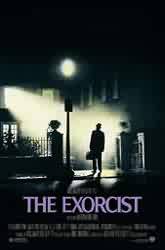 |
The Exorcist (Director's Cut) 
(Dir: William Friedkin, Starring Ellen Burstyn,
Jason Miller, Linda Blair, Max von Sydow, Lee J. Cobb, Jack MacGowran, Rudolf Schündler,
Kitty Winn, Reverend William O'Malley, Vasiliki Maliaros, Titos Vandis, Barton Heyman,
Robert Symonds, Donna Mitchell, and Mercedes McCambridge)
more
BY: DAVID PERRY |
"I know that there's been a lot of controversy about
certain scenes that are out of the film, particularly the last scene. My feeling as
the interpreter of that material was that we don't need it."
Those are the words of The Exorcist director
William Friedkin just two years ago in a BBC documentary called The Fear of God: The
Making of the Exorcist. Then, the film's screenwriter and novelist, William
Peter Blatty (who would later go on to direct Exorcist III), was very outspoken
about the scenes that had been excised from The Exorcist before its release.
"I finally heard something in his voice a year ago
that made me want to go back and look at it again. It wasn't easy for me to say to
him after 27 years, 'you know what? I think I was wrong.'"
Now we have a director's cut of The Exorcist
with 11 minutes of previously unused material. While there are some small additions
of little importance (including a inexplicable addition to the opening titles and a change
of the bar music to "Ramblin' Man"), the whole idea of this cut is in four
sequences of varying importance.
The first is an early medical test on Regan (Blair), the
daughter of a famous actress (Burstyn) that has been possessed by the demon Pazuzu (voiced
by McCambridge). This sequence is the least called for by Blatty and the lesser
known of the three, but certainly stands as the only one that really works. The
first sight of the turn that Regan takes is much harsher here thanks to an earlier
placement in the story. Plus the end of the scene is a moment of comic relief, in
what is otherwise a sparsely depressing period in the film, this scene keeps the audience
on their toes both.
The most noted of the four is the second one, titled the
spider walk. This scare tactic is one that has always looked good by itself on
various specials on the film, but inside the story it fails miserably. This scene in
the film is meant to let you know just how far Regan has gone, not how malleable her body
is for the demon. The film has been long noted for its non-horror film sensibility.
While there are many scenes that grab the audience with horrific images, this is
the first one and it comes way too early. The head rotation is still the best, and
it seems old-shoe after the spider walk.
The third is a conversation between the two exorcists,
the feeble by faith Father Karras (Miller) and the feeble by age Father Merrin (von
Sydow). This is a type of release for the audience from the long period of the
exorcism. While its addition does more to delve into the two characters, its
addition does nothing to help the film. The old edit of this scene, featuring the
two priests silently reflecting the actions in front of them, is more poignant and, in my
opinion, much more telling of the two characters.
And the fourth is the rub, the real gaffe on the part of
Blatty and Friedkin. The original has a beautiful subtle ending, one that holds true
to the French New Wave teachings that went into Friedkin's style as that time. It is
an incredible finale to a great film. Now, the scene is longer, with a horrendous
conversation between two of the film's survivors. This scene was meant as a chance
to let the audience know that life goes on, but it only makes the film keep lugging along.
Today, films continue for final exposition, but in 1973 it was more acceptable to
end the film when the story was over. And that it was before: over.
The original The Exorcist was my choice for the
best film of 1973, going beyond Ingmar Bergman's Cries and Whispers, George Roy
Hill's The Sting, Terrence Malick's Badlands, Bernardo Bertolucci's Last
Tango in Paris, Fred Zinnemann's The Day of the Jackal, and Peter
Bogdanovich's Paper Moon. And I still stand beside that decision. The
original is one of the best films ever made, and no new cut can completely ruin its
intensity. These additions merely make it less enthralling than it was, but not that
less of an achievement.
Earlier this year, Joel and Ethan Coen reissued their
1984 indie classic Blood Simple with a leaner, tighter directors cut. For
them, the film seemed to lug along needlessly in its old form and deleted some five
minutes. That was a great directors cut, not only did it give a new aspect to the
film, but also made the film better. Friedkin's directors cut does not understand
this. To make a different film on the second try is a must, to make it better, or at
least comparable, is preferred.

BUY THIS FILM'S
  
FROM AMAZON.COM |
REVIEWS OF THIS FILM
   |
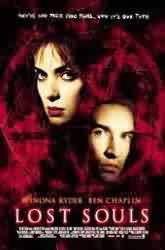 |
Lost Souls

(Dir: Janusz Kaminski, Starring Winona Ryder, Ben
Chaplin, Sarah Wynter, John Diehl, Elias Koteas, John Hurt, Philip Baker Hall, W. Earl
Brown, Alfre Woodard, and Ashley Edner)
more
BY: DAVID PERRY |
For years, Janusz Kaminski has served as one of the
finest cinematographers in the world. He has been nominated for Best Cinematography
by critic's groups 10 times (winning seven times), 4 nominations from cinematographer
guilds (winning once), and even three nominations for the Best Cinematography Academy
Award (winning twice). His achievements include Schindler's List, Jerry
Maguire, and Saving Private Ryan. But none of these skills can help
him to craft a good film out of a bad story.
Like master-composer John Ottman's Urban Legends:
Final Cut, Kaminski's directorial debut, Lost Souls, is further proof that
cinema skill workers should not begin their directorial career with a horror film.
It may have worked for Charles Laughton, but that was 1955 -- and Laughton had something
interesting to work with. Will these guys ever learn? It's almost like they
jump at their first chance to direct without even reading the script.
Lost Souls is about Satan coming to earth, but
looks more like the second coming of End of Days. Its protagonist, waif
extrordinaire Winona Ryder, plops around various lowly places with the dazed and confused
look of a person hit in the head with a two-by-four. Yeah, she at least seems her
age this time (see Autumn in New York -- but don't really see it, trust me), but
that does not mean that the character has grown any brighter.
Ryder's character, Maya Larkin, is learned in the art of
exorcisms, spending time with an elderly priest Father Lareaux (Hurt) whose last exorcism
left him hospitalized and his subject (Diehl) in a coma. Her search through papers
and books leads her to believe that the antichrist is to be true crime writer Peter Kelson
(Chaplin).
This Rosemary's baby acts like a more dramatic David
Arquette -- and even has the mindset of that 1-800-COLLECT artist. Kelson does not
believe what Maya and her accomplice in faith (Koteas) tells him, even though everyone in
his family seems insidious enough to be part of some underground satanic group.
Plus, Peter is so dimwitted that he doesn't notice that XES is sex backwards, so let's not
even think about how much this nitwit should listen to himself.
Besides some great casting choices (Philip Baker Hall is
terrific as Kelson's priest uncle), the only reason to see this film is for its filming.
Kaminski and cinematographer Mauro Fiore make a beautiful canvas for such a flawed
film. The lighting of nearly every conversations sequence is astounding enough to
make the audience forget just how insipid the conversation actually is. Lost
Souls is cinematic hog wash. Albeit beautiful looking hog wash, but hog wash
all the same.
Screenwriter Pierce Gardner should keep his day job,
producing pitiful films like Fatal Instinct and Getting Even with Dad.
The dialogue is redundant and devoid of any gracefulness. It's like taking
one of those poetry magnets to create dialogue exchanges.
I'm sure that most people will find most fault in the
film's anticlimactic ending. Even I was astounded that it stopped like it did, but I
will say that doing so was a better idea than the immensely ridiculous fight in the subway
from End of Days. For the film to set itself as a psychological thriller
for so long, to head into a big action sequence would have been suicide. If the film
was not already dead on arrival.

BUY THIS FILM'S
  
FROM AMAZON.COM |
REVIEWS OF THIS FILM
   |
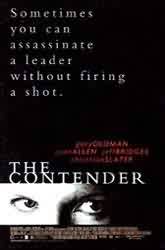 |
The Contender 
(Dir: Rod Lurie, Starring Joan Allen, Jeff
Bridges, Gary Oldman, Sam Elliott, Christian Slater, William L. Petersen, Saul Rubinek,
Mike Binder, Robin Thomas, Andrew C. Boothby, Philip Baker Hall, Kristen Shaw, and Mariel
Hemingway)
more
BY: DAVID PERRY |
There has been a long standing belief that any criticism
towards Rod Lurie's previous film Deterrence and current film The Contender
would be in jealousy. I mean, this guy was once a film critic himself -- and
everyone knows (or at least believes) that every film critic is merely a wannabe
filmmaker. So why don't we just band together and try to ruin the hopes and dreams
of one of our own? Because we don't have to -- Lurie sufficiently gives us films
that are so laughably lackluster that we don't even have to do the work.
And that's not to say that Lurie does not have potential,
some of his camera setups are really good, it's merely that he has not given us an
achievement anywhere near those of critics-turned-directors like Peter Bogdanovich and
François Truffaut. There is nothing to say that he cannot grow into his career
peers, but I feel that it is going to be a pretty long wait.
The Contender begins with a car careening off a bridge
after a bright period -- perhaps meant as foreshadowing for how the film starts off high
and slowly makes its way into the gutter. The woman inside the car dies, but her
death does make a big difference for the country. The person that jumped into the
river to save her was Governor Jack Hathaway (Petersen), who is the front-runner for the
position of vice president following the previous vice president's untimely death.
With this drowning affair, the bigwigs in the Democratic Party deem the death and failed
saving too close to the Ted Kennedy affair and decide not to take Hathaway for the
position.
So President Jackson Evans (Bridges) decides that the
best remaining person for the job is Laine Hanson (Allen), a loving spouse and parent,
and, best of all, a woman. But there's also the questionable addition of 'sex fiend'
as uncovered from her shady college sorority past. The main denouncer of her
confirmation is Republican Representative Shelly Runyon (Oldman), who would much rather
see Hathaway confirmed.
When the secrets leak out about her sorority life, Runyon
makes it a major point in the Senate hearings in deciding to confirm Laine. As head
of the committee, Runyon makes sure that there is a swing vote towards his side, gaining
the efforts of young liberal upstart Reginald Webster (Slater).
And that is the real secret agenda behind Lurie's film:
Democrats = good, Republicans = bad. It's like a jaded capsule to easy politics.
There's no such thing as a respectable Republican in the film, and only two
Democrats that people might (keyword: might) frown upon. I have nothing against
filmmakers getting their politics in their films (i.e. my great deal of respect for Oliver
Stone's Nixon), but I cannot feel much for a film that seems completely tied
around its political leanings. Runyon is painted as a modern day Joe McCarthy
because he believes that there is someone better for the job than the appointee.
Shouldn't people be more worried that the lesser person for the job is on the road to
being made vice president?
I can now see why Gary Oldman is actually up-in-arms over
the film -- it is a political monstrosity. I'm not saying that if the roles were
reversed and the Republicans were the ones in the light, then we'd like it. It's
just that what is really needed is a film that is not so politically black and white.
These are hostile times, what with an election less than
a month away, and one can only guess that this film's politics helped it gain such a prime
release from DreamWorks, which is owned by three very prominent liberals in Hollywood.
Their small editing touches have caused Oldman to say that is character is nearly a
completely different one from the character he played. Like the director's cut of The
Exorcist, this film serves as further proof that editing can make all the difference
in the attraction of certain aspects of a film.
Lurie may let his feelings get out of hand, but it is his
storyline that hurts the film the most. The story literally plods along into a
laughably bad third act. The so-called moment of truth near the end made me cringe
and the wannabe martyr to her beliefs Hanson character is one of the lesser dynamic
protagonists this year. Lurie has a fine grasp of camera placement and dialogue
(President to Hathaway: "You're the future and the Democratic Party -- and you always
will be"), but his story does not quite cut it.
The only great standout to this film, however, is its
performances. Though I did not care for her character, Allen gives another great
performances for the listing. Since 1995, Allen has given a beautiful performance
every year, only pausing from doing a film last year. I'm fairly sure that Allen
will pick up an Oscar nomination for this film, which she does deserve. But if she
wins over Björk for Dancer in the Dark, then I'll be very unhappy.
And I love Gary Oldman. He really is one of the
greatest actors in the history of the cinema. Though a bit too much of a heavy too
often, his Shelly Runyon is more respectable than Lurie would like him to be thanks to the
way conservative Oldman creates him. By the end I respected him much more than
the boring vice presidential appointee or the goofy president.
In smaller roles, Sam Elliott, Saul Rubinek, and even
Christian Slater give nice performances that create enough tension with their scene
sharing leads that they deserve recognition on their own. And then there's Philip
Baker Hall, who has made a career out of playing great, memorable smaller characters
(though the ones he played last year were for better films [The Talented Mr. Ripley,
Magnolia, Cradle Will Rock, The Insider] than the ones for this
year[Rules of Engagement, Lost Souls, The Contender]).
The Contender will probably hit it off pretty
well in the industry. Hollywood is renowned for being left-winged and there is no
doubt in my mind that they will find more fault in the GOP characters than in their own.
Expect the film to see a nice fate with the Academy Awards, where it may even grab
that single unworthy nomination (how else to explain The Green Mile, Four
Wedding and a Funeral, Scent of a Woman, and Ghost getting Best
Picture nominations?). I guess that it'll have to be just me and Gary Oldman nodding
our heads in dismay.

BUY THIS FILM'S
  
FROM AMAZON.COM |
REVIEWS OF THIS FILM
   |
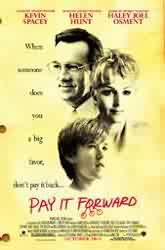 |
Pay It Forward 
(Dir: Mimi Leder, Starring Haley Joel Osment,
Helen Hunt, Kevin Spacey, Jay Mohr, Jim Caviezel, Angie Dickinson, David Ramsey, Shawn
Pyfrom, Marc Donato, Jon Bon Jovi, Gary Werntz, Colleen Flynn, Kathleen Wilhoite, and Liza
Snyder)
more
BY: DAVID PERRY |
When there was no audience friendly, cringe-worthy
comedy/drama to tarnish last Fall/Winter, it seemed too good to be true. To think
that there has not been a film as despicable in the same vein as Patch Adams is
hard to believe. Of course, it could not last forever -- Pay It Forward has
come to the rescue.
Mimi Leder's film is a contrivance in sappiness.
There are some films that leave me thinking that there is no real reason to expect much
from Hollywood films these days. For every The Insider, there's almost
always a Light It Up and a The Other Sister -- these are the films that
nightmares are made of. And while Pay It Forward is not near as bad as any
of the aforementioned titles, it is not that far.
Haley Joel Osment's Trevor McKinney screams invention of
needed optimism in a cynical world. For the readers of Catherine Ryan Hyde's novel,
he must have seemed like a small angel, doing good work for the world. But on
screen, he's just that cute kid from The Sixth Sense with a rinky-dink plan of
compassion, however far fetched it may be. I love the fact that it tries to give
credence to the catching on of Trevor's idea by his mom saying that he'll do anything
until it is finished. Aww, how sweet.
Trevor has been given an assignment in his social studies
class from a Mr. Eugene Simonet (Spacey; who never really teaches any social studies in
any of the film) to come up with a plan that will change the world. Trevor comes up
with 'paying it forward' where people do good deeds for one another. Three good
deeds, to be exact, as a sort of pay back for the previous nicety.
He starts off by bringing a homeless man into his house
with food, shelter, and a little money. For him, this is the best thing he could do,
allowing this man to have something great happen to him in his moment in need.
Before long, we see people stop suicides and give away Jaguars to wreck victims.
Actually that wreck victim is a down on his luck Los
Angeles magazine writer (Mohr), who begins searching for the starting point of this
movement leading him back to a harsh gun-toting convict (Ramsey) and a alcoholic old lady
(Dickinson) living in her car. The search is paralleled beside the up start of the
movement in Las Vegas.
Trevor's mom Arlene (Hunt) is the one most in need of
help, but she is not on his agenda. Instead, he sees a chance in helping Mr. Simonet
by trying to get him with his mom, killing two birds with one stone. Each of them
have their own problems, Eugene cannot get beyond his horrible facial scarring and Arlene
cannot get beyond her struggle against alcoholism.
The film is sloppily made, with direction that veers
towards aimlessness. Mimi Leder is not a horrible director, as was proven with Deep
Impact, but what she has here is not something that her skills can take on. A
tidal wave she can film, but a kid in a classroom is a bit tough.
Spacey gives his requisite great performance, though it
seems a little too easy for him this time around. Following Hurlyburly, American
Beauty, and The Usual Suspects, one would expect some more dynamic
performances to come, but the characters that have come out of this and The Big Kahuna
have been far from his creative ability. The man is a acting genius, up there with
James Stewart, but he does best when he works with everyman gone awry, not everyman gone
depressed.
The only person in this film that comes off better than
ever before is Osment. While I did not think that it merited an Oscar nomination,
his performance in The Sixth Sense was really one of the best things about that, more or
less, overrated film. He gives credibility to what could have been an otherwise
over-the-top character. Osment still throw in the cute kid poses, but there's some
acting dynamics there that few actors his age possess.
I have a great deal of problems with screenwriter Leslie
Dixon. While this is the best of the seven films that she has written (Outrageous
Fortune, Overboard, Mrs. Doubtfire, Look Who's Talking Now,
That Old Feeling, and The Thomas Crown Affair), it is nothing to
consider notable. There's dialogue that hurts the film thanks to Leder's inability
to grab what is being said. Actually, I even had trouble catching what was trying to
be said.
At one point Jay Mohr states that this is a movement that
has gotten all the way to Los Angeles. But there is nothing in the film to really
convince the audience of that. Besides the three aforementioned 'pays,' we never see
anyone doing the pay it forward thing outside of Trevor. There's no montage of
people helping people that might have helped the story work better. Even Ghostbusters
knew to show the ghosts invading the city to let the audience know that there were ghosts
invading the city. Perhaps I'm that cynic that this film is against, but I have a
hard time believing that this thing has gone into movement status unless I see it happen.
The film itself hurts more than it helps. By the
film's final act, I was tired with what it was trying to jam down my throat. When it
ended I was running to the exit. The film kills itself in the closing moments, both
with a surprise climax that struggles aimlessly between sappiness and pointlessness.
When the closing shot rang in the hearts of some of the previewers I saw it with, I
was thinking of how unpredictably pushed it was.
I have read one reviewer compare it to a Frank Capra
film. This is not a Frank Capra film by any stretch of the imagination. While
Capra knew how to tug at the heart strings of the audience and make them feel better about
themselves and the world around them, this is instead lost in its oblivion of
divisiveness. It's like Capra-lite, with all the thick margarine thrown in for good
measure.

BUY THIS FILM'S
  
FROM AMAZON.COM |
REVIEWS OF THIS FILM
   |
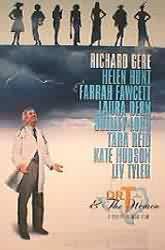 |
Dr. T & the Women 
(Dir: Robert Altman, Starring Richard Gere, Helen
Hunt, Laura Dern, Farrah Fawcett, Shelley Long, Tara Reid, Kate Hudson, Liv Tyler, Lee
Grant, Robert Hays, Matt Malloy, Andy Richter, Janine Turner, Gail Cronauer, Wren Arthur,
Irene Cortez, Mackenzie Fitzgerald, Holly Pelham, and Zane Michael Scott)
more
BY: DAVID PERRY |
As I sat watching Robert Altman's Dr. T & the
Women, I finally caught onto something: the secret to Altman's success as an ensemble
filmmaker is that he tackles ensembles of different types. There was the down-home
Mississippians of Cookie's Fortune, the Jazz induced Midwestern gangland of Kansas
City, the movie-fed Hollywood producers of The Player, the French fashion
mavens of Prêt-à-Porter, the residential suburban Los Angeles hell of Short
Cuts, the country music revolving Nashvillians of Nashville, and even the
madcap American soldiers of MASH.
For some people, creating an ensemble of workable
characters every time for 35 years would be quite a task, but for Altman it is easy.
He just does a completely different world from the last one he did. The
Dallas socialites that run rampant in Dr. T & the Women may share the same
geographical region of the Mississippi town folk from Cookie's Fortune, but they are, in
many ways, a completely different world.
The women of Dallas, at least ones that Altman works with
here, are those of family wealth, where having work done means plastic surgery instead of
a task finished. These are posh, flighty, and demanding women. They know what
they want, and usually get it. They are the bearers of the Dallas society for the
next few decades, and intend on keeping it as decadent as possible.
And they also represent a huge percentage of this film's
characters. I counted 37 female roles on the IMDb, comparable to 6 men (two of which
have no dialogue). That is what is needed for this film. The title suggests
that the film is about a man philandering with various women -- further pushed by the fact
that the doctor is played by constant womanizer Richard Gere -- but that is not the case.
While he is the protagonist, without a doubt, the film is really about the way he
survives a world of so many women, all vying for his attention.
Dr. Sullivan Travis (Gere) tackles women everyday, as
they scream at, fight, and claw each other to get the next position on his waiting list.
You see, Dr. T (as he is affectionately called) is a gynecologist, working with the
upper-class Dallas women only. They all have nothing else to do in their rich lives
during the day, so they sit (more like mingle) in his waiting room, driving his
secretaries to the wall with requests.
While those thirty some-odd women try to get into his
office, he has women running around his home in hopes of getting his answer to everything.
The only person that is really independent of him is his wife Kate (Fawcett), who
is a mental institution after bearing all in a mall fountain. She suffers from what
is called the Hestia complex, in which she hates herself for getting all the undeserved
love generated from her husband and daughters. Every time Dr. T tries to visit her,
it seems like she is getting worse, even calling him her brother on one visit.
The two that most try to get him, though, are his
daughters. Dee Dee (Hudson) is a Texas Cowboys cheerleader, whose upcoming marriage
is the event of the season for everyone around. Though her wedding is really one of
convenience than for love, she feels that it is one of the most important parts of her
life. The other daughter is Connie (Reid), who works as a tour guide for the local
conspiracy museum (remember, we are in Dallas). She is a little jealous that all the
attention is going to Dee Dee, who, in her opinion, is making one of the worst
decisions of her life.
Richard Gere is a surprise in this film. Few people
have been as vocal in their disrespect for the actor than me, but even I'll make a
concession here. While there is nothing to make this a standout performance for most
people, Gere comes off better than he has since the 1970's. I have not liked Gere in
a film since Days of Heaven in 1978, and I really thought that that single
performance was a fluke, especially after films like Breathless, King David,
Mr. Jones, and Autumn in New York, all meant as major dramatic films for
the actor.
The cast of females are varied and, mostly, valuable.
While, Fawcett was nothing to really write home about, her sister played by Laura
Dern was one of the more hilarious aspects of the film. I love Laura Dern as an
actress, and think that it is always interesting to see her play roles that are distinctly
different from the naive women that she played early in her career (not that her David
Lynch films were lesser performances, in fact she has never given a better performance
than the one she gave in Wild at Heart).
Kate Hudson was all the rage a few weeks ago with Almost
Famous, still one of this year's best performances, but she does not deliver as
faithfully here. I was instead more interested in her sister played by Reid (notice a
pattern here?). I never really considered Reid to be much of an actress
following films like Body Shots and American Pie, so her stand-out
performance here was quite a treat.
The film may be far fetched most of the time, but it still
delivers. The screenplay by Anne Rapp, who also wrote Cookie's Fortune,
brings in enough characters for Altman to go crazy with and story arcs that are
continually funny.
Altman is really a king of ensemble films. This is
further proof that his ability to create a world of 3 Women and Brewster
McCloud has not died in the eyes of comedies. While, there's nothing to really
make this comparable to, say, Short Cuts, this is still a nice film from a man
that can create a visual splendor out of a multitude of characters. Or, at least
this time around, a multitude of screaming female characters.

BUY THIS FILM'S
  
FROM AMAZON.COM |
REVIEWS OF THIS FILM
   |
Reviews by:
David Perry
©2000, Cinema-Scene.com
http://www.cinema-scene.com









